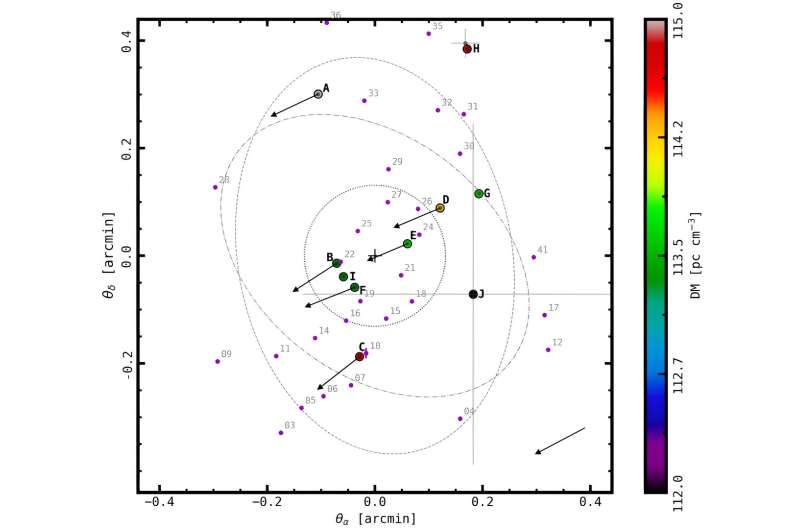March 28, 2024 report
This article has been reviewed according to Science X's editorial process and policies. Editors have highlighted the following attributes while ensuring the content's credibility:
fact-checked
preprint
trusted source
proofread
Three new millisecond pulsars detected with MeerKAT

Using the MeerKAT radio telescope in South Africa, an international team of astronomers has detected three new millisecond pulsars in the globular cluster Messier 62 (also known as NGC 6266). The finding was detailed in a research paper published March 18 on the pre-print server arXiv.
Pulsars are highly-magnetized, rotating neutron stars emitting a beam of electromagnetic radiation. The most rapidly rotating pulsars, with rotation periods below 30 milliseconds, are known as millisecond pulsars (MSPs). Astronomers assume that they are formed in binary systems when the initially more massive component turns into a neutron star that is then spun up due to accretion of matter from the secondary star.
In the paper, a group of astronomers led by Laila Vleeschower of the University of Manchester, UK, reports the discovery of three new pulsars of this type in Messier 62, or M62, which is known to host seven binary pulsars. The finding was made as part of the TRAnsients and PUlsars with MeerKAT (TRAPUM) project.
"Using MeerKAT, we have discovered three new millisecond pulsars (MSPs) in the bulge globular cluster M62: M62H, M62I, and M62J," the researchers wrote.
The three newfound MSPs are binary systems. Therefore, all of the 10 pulsars identified in Messier 62 turned out to be binaries. According to the astronomers, the fact that only binary pulsars have been detected in Messier 62 is surprising, in contrast to what is observed in other known GCs—where isolated pulsars are easier to find.
M62H has a spin period of about 3.7 milliseconds and a dispersion measure of 114.7 pc/cm3. Its companion has a minimum mass of approximately 0.00236 solar masses (2.5 Jupiter masses), which makes M62H a binary with the lightest companion known to date in a GC. The orbital period of the system was measured to be 0.133 days.
M62I rotates once in approximately 3.3 milliseconds and its orbital period is about 0.51 days. The pulsar has a dispersion measure of 113.35 pc/cm3 and its companion has a minimum mass of 0.15 solar masses. The collected data also allowed the astronomers to derive the characteristic age of M62I, which was found to be at least 278 million years, and the surface magnetic field that is estimated to be lower than 795 million Gauss.
When it comes to M62J, it has a spin period of 2.76 milliseconds and its dispersion measured was found to be 111.98 pc/cm3. Given that the researchers were unable to obtain a timing solution for M62J, the rest of its properties remain unknown.
Besides the detection of three new pulsars in Messier 62, the authors of the paper also updated long-term timing solutions, with a data span of over 23 years, for six previously known pulsars in this cluster
More information: Vleeschower et al, Discoveries and Timing of Pulsars in M62, arXiv (2024). DOI: 10.48550/arxiv.2403.12137
Journal information: arXiv
© 2024 Science X Network




















